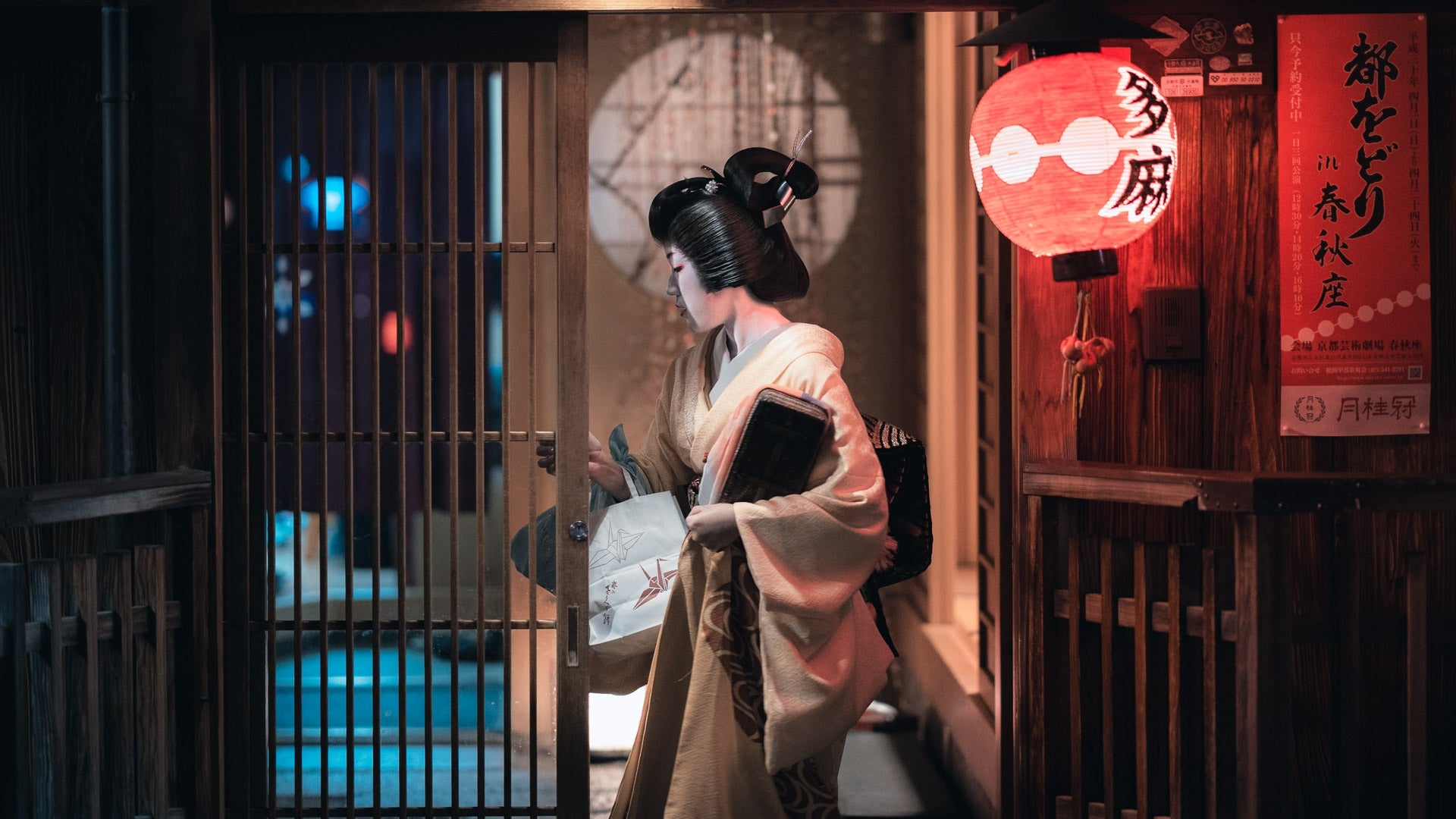The rush of photographing Geisha in Kyoto can be a bit like fanboying over your favourite celebrity.
They’re people to become bewildered by. They’re beautiful. Elegant. Elusive. Mysterious.
…and they’re also gone in a flash. That is, if you ever get a chance to see one.
Geiko (Which is Kyoto dialect for the word “Geisha”) have become great icons of tourism in Japan; a representation of the rich history and culture people want to experience when they come to the land of the rising sun.
They’re a “bucket list” item now, which is kind of sad to say. And photographing them feels kind of like a paparazzi gig you were unknowingly hired to do.
It can feel kind of weird sometimes to actively try to find and photograph them to show your friends back home. But don’t feel bad, there’s a right way and a wrong way to do it, and generally, Geisha understand that they have an importance in Japanese culture and that being in the public eye is part of the role too.
With that being said, it’s well known that Geisha are extremely elusive, appearing and disappearing in a flash. Here’s some tips to help your success rate of photographing Geisha in Kyoto.

Geiko and Maiko
First, let’s talk about the difference between Geiko and Maiko. It helps to know what you’re photographing, right?
A Geiko (Geisha) is a professional entertainer and performer, usually hired to sing, dance, serve and entertain guests at dinners and special occasions. There’s nothing shady, sexual or suspect about them, as some people may think. They’re beautiful people in a beautiful job.
A Maiko is an apprentice Geiko. She’s usually quite young (between 15 to 19 years old), and typically spends at least 5 years in training before mastering the many skills required to become a fully fledged Geiko.
To the untrained eye, it can be difficult to distinguish whether the woman you are looking at is a Geiko or a Maiko. But here’s some tips to help you get it right every time:
- The obi (belt of the kimono) of a Maiko (called the Darari obi) is very long at the back and almost reaches the floor. It’s usually decorated with intricate patterns and designs that sometimes represent the spirit of the Maiko, and they also feature the crest of the house they belong to.
- The obi of a Geiko is small, simple and square at the back. Usually in a single colour, refined and restrained, like the rest of a Geiko’s kimono.
- Maiko almost always have decorations in their hair, jewels, flowers etc. A Maiko’s hairstyle changes and represents what level of experience she has (if not for a specific occasion), while Geiko almost never have decorations in their hair that flashy.
- Shoes are a bit harder to spot, but typically a Maiko’s shoes are high wooden platform shoes with slants on the front. These are called “Okobo”. Typically Geiko’s shoes are less platform and shorter in either a Zori or Geta style.

See the trend here?
Typically, a Maiko spends her training years wearing flashier or louder outfits, and overtime becomes more refined, pared down and simple.
Most of the time when wandering the streets of Kyoto, you tend to see far more Maiko than Geiko.
Also, don’t fall for the fake ones when photographing Geisha in Kyoto - it’s pretty common for tourists to dress up like Maiko, and Japanese nationals also tend to dress up in kimono for special occasions anyway, so sometimes it can be visually confusing distinguishing which is which.
As a rule of thumb, if she’s hurrying (seriously, some of them can really power walk in those shoes) from one place to another, it’s probably a Maiko or Geiko. They’ll almost never stop to talk or to take pictures with anyone.
Be respectful
This is huge.
It’s not uncommon to see a horde of people on the street waiting for a Maiko to come out of a house. When she does, it’s like as if Justin-friggin-Bieber just rocked up and started handing everyone ice cream. It’s wild.
This… is obviously not how it should be.
Here’s what you should do:
- Take photos from a distance, and only from the sides or behind.
- Never get in the walking path of a Geiko or Maiko.
- Don’t stop them.
- Don’t try to take selfies with them.
- Most of all, don’t touch them.
Geisha are humans too, not objects. Having returned to Kyoto many times and finding myself on many Geisha photography adventures, I can’t tell you how many times I’ve felt so sorry for them after witnessing the harassment they go through sometimes.
When you see them, remember, they’re working a normal job just like everyone else. Usually when they appear on the street, they’re walking from establishment to establishment, going from job to job. Just like how your local trade/service person would in your local area.
Personally, when trying to be as respectful as possible but still wanting the shot, I try to use a longer lens to capture them far away, and if they so happen to be walking my way, I get out of their path and usually give them a smile, a quick bow and a thank you.

Time
The aim of the game is to try to see them when they’re walking from place to place.
Typically, Geisha have evening jobs, usually at one or two establishments. The main time these engagements typically start to happen is between 5-6pm, depending on the neighbourhood and time of year.
This is the best time to see them. Any other time of day and you reduce your chances dramatically.
Personally if it’s not 5-6pm, I don’t even bother. If your luck is good though, definitely give it a go at other times too.
Location
There’s only really 4 areas you can go when photographing Geisha in Kyoto.
These areas are called “hanamachi”, or, Geisha districts.
These districts are:
You’ll know you’re in these districts when you get there. The traditional Japanese architecture of these neighbourhoods is what gives Kyoto the “classic Japan” feel. It’s picturesque around every corner.
The most famous of these districts is definitely Gion, with many tourists crowding around “Gion Corner”, one of the big performance theatres in this area.
Close by, Ponto-cho alley is also another a good location to get a great feel for Kyoto and to potentially spot some Geisha too.
As for specific photography locations, perspectives and streets, I’m saving all my best locations for my upcoming book called “A photography guide to Japan”, which will contain my top 50 photography locations across the country. Be on the lookout for that in early 2020.

Photography tips
For actually photographing Geisha in Kyoto, use a long lens and stand further back from the subject.
Remember to watch out for your backgrounds. There’s a lot of tourists around, and isolating the Geisha among the crowd can be difficult. But also, there’s plenty of fantastic architecture around which provides a great setting for your photographic story. Good context can turn an okay photo into a great one.
For shutter speed, go fast, as those Maiko especially can move pretty quickly. A minimum shutter speed of 1/400sec is decent, but if you really want to freeze the motion, try for something like 1/1000sec.
Learn how to use continuous focus and the correct focus point modes. Modes like AF-C and Servo with a good AF point can mean a world of difference when you only have a few seconds to capture your subject. You should also be using these continuous-type focusing modes for moving subjects anyway, so learn how to master them.
Have fun with it!
I’ve been out on missions attempting to photograph Geisha in Kyoto and have come back empty handed many times. Don’t expect to be able to nail your experience every time.
It’s kind of like going to Japan to see the temperamental and ephemeral Cherry Blossoms, if you get it, fantastic. If not, that’s fine too. Remember, the whole experience wasn’t about just that anyway, but with these tips, you’ll up your chances immensely.
Have fun with it, and good luck out there.





0 comments